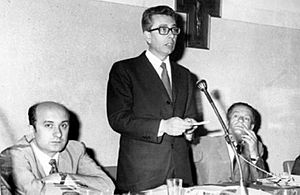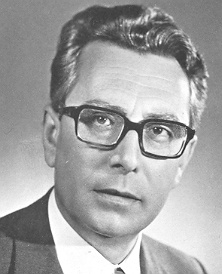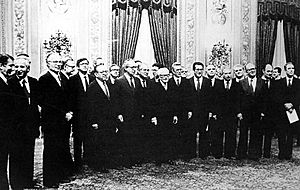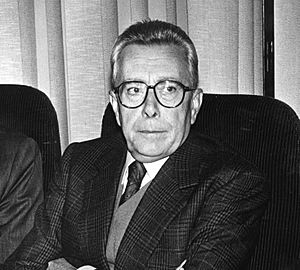Arnaldo Forlani facts for kids
Quick facts for kids
Arnaldo Forlani
OMI OESSH
|
|
|---|---|
 |
|
| Prime Minister of Italy | |
| In office 18 October 1980 – 28 June 1981 |
|
| President | Sandro Pertini |
| Preceded by | Francesco Cossiga |
| Succeeded by | Giovanni Spadolini |
| Deputy Prime Minister of Italy | |
| In office 4 August 1983 – 18 April 1987 |
|
| Prime Minister | Bettino Craxi |
| Preceded by | Ugo La Malfa |
| Succeeded by | Giuliano Amato |
| Minister of Foreign Affairs | |
| In office 30 July 1976 – 5 August 1979 |
|
| Prime Minister | Giulio Andreotti |
| Preceded by | Mariano Rumor |
| Succeeded by | Franco Maria Malfatti |
| Minister of Defence | |
| In office 23 November 1974 – 30 July 1976 |
|
| Prime Minister | Aldo Moro |
| Preceded by | Giulio Andreotti |
| Succeeded by | Vittorio Lattanzio |
| Secretary of the Christian Democracy | |
| In office 22 February 1989 – 12 October 1992 |
|
| Preceded by | Ciriaco De Mita |
| Succeeded by | Mino Martinazzoli |
| In office 9 November 1969 – 17 June 1973 |
|
| Preceded by | Flaminio Piccoli |
| Succeeded by | Amintore Fanfani |
| Member of the Chamber of Deputies | |
| In office 12 June 1958 – 14 April 1994 |
|
| Constituency | Ancona |
| Personal details | |
| Born | 8 December 1925 Pesaro, Marche, Kingdom of Italy |
| Died | 6 July 2023 (aged 97) Rome, Italy |
| Political party | DC (1946–1994) Independent (since 1994) |
| Height | 1.78 m (5 ft 10 in) |
| Spouse | Anna Maria Forlani (died 2015) |
| Children | 2 |
| Alma mater | University of Urbino |
| Occupation | |
Arnaldo Forlani (8 December 1925 – 6 July 2023) was an important Italian politician. He served as the 43rd Prime Minister of Italy from 1980 to 1981. He also held other major roles, including Deputy Prime Minister, Minister of Foreign Affairs, and Minister of Defence.
Forlani was a leading member of the Christian Democracy party, which was a major political force in Italy for many years. He was one of the most well-known Italian politicians from the 1970s to the early 1990s.
Contents
Early Life and Political Start
Arnaldo Forlani was born on December 8, 1925, in Pesaro, a city in Italy. He came from a middle-class family. After studying law at the University of Urbino, he began his political journey in 1948.
He first worked as a local secretary for the Christian Democracy party in Pesaro. Later, he was elected to local and regional councils. In 1954, he became part of the Christian Democracy's main committee, which helped guide the party.
In 1958, Forlani was elected to the Chamber of Deputies, which is like Italy's House of Representatives. He represented the area of Ancona. By 1959, he became a key figure in a group within the Christian Democracy party led by Amintore Fanfani. From 1962 to 1969, he served as the party's vice-secretary.
Leading the Christian Democracy Party
In December 1968, Forlani became the Minister of Public Shares. This role involved overseeing state-owned companies. In August 1969, he became the Minister for Relations with the United Nations, helping Italy work with other countries.
In November 1969, Forlani was chosen as the Secretary of the Christian Democracy party. This was a very important leadership position. As secretary, he tried to keep the center-left political alliance strong. This alliance included the Christian Democrats and other parties like the Socialists and Republicans. He wanted to make sure these parties worked together, even when Italy faced economic and social problems.
During his time as secretary, a law allowing divorce was passed in 1969. This law was strongly opposed by the Christian Democrats. The Prime Minister at the time, Mariano Rumor, resigned in 1970 due to political tensions. After him, Emilio Colombo became the new Prime Minister.
Presidential Election and New Elections
In 1971, Italy held a presidential election. Forlani suggested Amintore Fanfani as the Christian Democracy's candidate for President of the Republic. However, other parties did not agree. His second choice, Aldo Moro, was also not elected. Finally, Giovanni Leone became president with support from different parties.
After some political difficulties, new general elections were called for May 1972.
1972 General Election Results
In the election on May 7, 1972, the Christian Democracy party, led by Forlani, kept its strong position. The Communist Party also maintained its support. The Socialist Party saw a decrease in votes. A notable change was the growth of the post-fascist Italian Social Movement, which almost doubled its votes.
After the election, Giulio Andreotti tried to form a government. However, this government only lasted a year. Then, Mariano Rumor returned as Prime Minister, leading a traditional center-left alliance. At the same time, in 1973, Forlani was replaced as party secretary by Amintore Fanfani.
Serving in Government Roles
In March 1973, Prime Minister Rumor's government faced challenges. One major event was the 1974 Italian divorce referendum. The Christian Democrats wanted to make divorce illegal again, but the Italian people voted to keep the divorce law.
Minister of Defence

After the referendum, Aldo Moro formed a new government. Forlani was appointed Minister of Defence. This meant he was in charge of Italy's armed forces. However, new problems arose after the 1975 regional elections, which led to calls for new national elections.
In March 1976, Forlani ran for the party secretary position again. He was against Benigno Zaccagnini, who supported working more closely with the Communists. Forlani lost this election, and Zaccagnini remained secretary.
Minister of Foreign Affairs
When the government collapsed in 1976, early elections were held. After the elections, Giulio Andreotti became the new Prime Minister. Forlani was then appointed as Minister of Foreign Affairs. This was a very important role, especially during the Cold War, a period of tension between major global powers.
As Foreign Minister, Forlani worked to strengthen Italy's relationships with other countries. He strongly supported the process of European integration, which aimed to bring European countries closer together. He also supported Portugal joining the European Economic Community, a group of European countries working on economic cooperation.
Prime Minister of Italy
In 1980, Arnaldo Forlani played a key role in helping Flaminio Piccoli become the Christian Democracy party's secretary. Because of this, Forlani was chosen to be the Prime Minister of Italy. He led a government that included the Christian Democrats, Socialists, Social Democrats, and Republicans.
Forlani was known as a calm politician who tried to avoid arguments within his party. He was seen as someone who could bring the Christian Democracy party together. As Prime Minister, he had to deal with challenges like political problems and a rise in left-wing terrorism.
1980 Irpinia Earthquake
During his time as Prime Minister, Forlani also had to manage the aftermath of the 1980 Irpinia earthquake. This was a very strong earthquake that hit the Campania region of Italy. It caused a lot of damage, killing many people and leaving hundreds of thousands homeless.
Forlani's government spent a lot of money on rebuilding efforts, and other countries also sent aid. Sadly, some of the money meant for rebuilding was misused or stolen, which was a big problem that came to light later. This made it harder for the affected communities to recover.
After Being Prime Minister
After his time as Prime Minister, Forlani remained an important politician. In 1981, he and Socialist leader Bettino Craxi made an important agreement. This agreement, sometimes called the "pact of the camper," recognized that other non-Christian Democratic parties were equally important in forming governments. It also allowed for different parties to take turns leading the government. This led to the formation of a new government alliance called the "Pentapartito."
In 1983, Bettino Craxi became Prime Minister, and Forlani served as his Deputy Prime Minister.
Second Term as Secretary
Forlani was elected secretary of the Christian Democracy party for a second time in 1989. He received a large majority of votes. At this time, Ciriaco De Mita, the former secretary, was the Prime Minister.
The relationship between De Mita's government and the Socialist party became difficult. Eventually, the Socialists withdrew their support, and De Mita had to resign in May 1989. Forlani then helped manage the political situation until Giulio Andreotti became Prime Minister in July, leading a new coalition.
1992 Election and Presidential Ambitions
In 1992, a major investigation into political corruption, known as Mani pulite (Clean Hands), began in Italy. This investigation revealed widespread issues within political parties.
In the 1992 Italian general election, the Christian Democracy party, led by Forlani, lost many votes. However, their coalition still managed to hold a small majority. Forlani was then proposed as the Christian Democracy's candidate for President of the Republic in the 1992 Italian presidential election. However, he did not get enough votes to be elected and eventually withdrew his candidacy.
Resignation and Retirement
The defeat in the presidential election, combined with the difficult general election and the ongoing corruption investigations, marked the end of Forlani's active political career. He resigned as party secretary in October 1992 and later retired from politics.
Death
Arnaldo Forlani passed away on July 6, 2023, at the age of 97.
Electoral History
| Election | House | Constituency | Party | Votes | Result | |
|---|---|---|---|---|---|---|
| 1958 | Chamber of Deputies | Ancona–Pesaro–Macerata–Ascoli Piceno | DC | 41,364 | ||
| 1963 | Chamber of Deputies | Ancona–Pesaro–Macerata–Ascoli Piceno | DC | 57,466 | ||
| 1968 | Chamber of Deputies | Ancona–Pesaro–Macerata–Ascoli Piceno | DC | 77,333 | ||
| 1972 | Chamber of Deputies | Ancona–Pesaro–Macerata–Ascoli Piceno | DC | 156,949 | ||
| 1976 | Chamber of Deputies | Ancona–Pesaro–Macerata–Ascoli Piceno | DC | 127,905 | ||
| 1979 | Chamber of Deputies | Ancona–Pesaro–Macerata–Ascoli Piceno | DC | 102,969 | ||
| 1983 | Chamber of Deputies | Ancona–Pesaro–Macerata–Ascoli Piceno | DC | 83,223 | ||
| 1987 | Chamber of Deputies | Ancona–Pesaro–Macerata–Ascoli Piceno | DC | 101,463 | ||
| 1992 | Chamber of Deputies | Ancona–Pesaro–Macerata–Ascoli Piceno | DC | 60,566 | ||
See Also
 In Spanish: Arnaldo Forlani para niños
In Spanish: Arnaldo Forlani para niños




